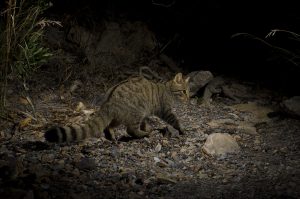The majority of species of carnivores of the Iberian Peninsula, are also carnivores of Extremadura, we can find here 11 species. Their activity is mainly nocturnal, although occasionally they can be seen during the day, mainly at dawn and dusk.
American mink Mustela vison

It’s an introduced mammal from farm escapes. Currently there is a population settled in the northeast of the community, always linked to aquatic environments. We can find it in the northern basin of the Tajo (Ambroz, Jerte and Tiétar). There it impacts negatively on the populations of the Pyrenean desman. It feeds on all types of vertebrates present in river ecosystems.
Badger Meles meles

Widely distributed throughout the Iberian Peninsula, also in Extremadura. Its presence is easily detected by the “tejoneras”, big burrows that it digs in the ground. It leaves them almost exclusively at night to feed on everything it finds: fruits, cereals, plants, small rodents, invertebrates…
Beech marten Martes foina

A small carnivore widely distributed throughout Extremadura, its populations are clearly expanding. Its diet is omnivorous, taking advantage of fruits such as blackberries or around fruit plantations in spring. The areas of Mediterranean forest and scrub are its favourites. On many occasions it approaches rural areas: stables, barns, cattle sheds, henhouses… Of clearly nocturnal habits, it is frequent to see specimens run over on the roads, mainly of young specimens in dispersion.
Common genet Genetta genetta

It is the most agile carnivore in Extremadura, typical of the Mediterranean forest, it needs wooded areas to be comfortable. It finds its ideal habitat in the Mediterranean forest, be it oak, holm oak, cork oak or pine. Its presence is easily detected because it accumulates excrement in latrines. Mostly nocturnal, it is difficult to see, although we can surprise them by crossing a road.
Egyptian mongoose Herpestes ichneumon

More diurnal than other carnivores of Extremadura, their populations are expanding towards the north of the country. It has long been present throughout the region. It has a predilection for areas of scrubland, in which we can surprise it by looking for small rabbits, reptiles, rodents or invertebrates.
European polecat Mustela putorius

This mustélid is not particularly abundant but is widely distributed throughout the region, always associated with aquatic ecosystems. It is difficult to see it in broad daylight except during the mating season, when we can surprise it by sunbathing. Like the American mink, it feeds on all kinds of vertebrates present in the rivers and nearby ecosystems.
European wildcat Felis silvestris

Its populations in Extremadura are important, we can find it throughout the region, in areas of forest and Mediterranean scrub. It tends to flee from human settlements, although it can occasionally hybridise with the domestic cat. Very elusive and mostly nocturnal habits, by day usually rest on top of some holm oak or sheltered in thick bushes. Although it is not abundant, we can find it all over the region, especially in mountains far from towns or cities.
Iberian lynx Lynx pardinus

It is probably the best known Iberian mammal, unfortunately because of its delicate state of conservation. Fortunately its populations are beginning to recover and in Extremadura the population is already around 100 specimens. They are distributed mainly in the valleys of Matachel, Hornachos-Alange, Valdecigüeñas, Ortiga and Valdecañas-Ibores.
Their sighting is very complicated due to the shortage of individuals. If you want some advice, click on the link. The juvenile specimens are more active during the day than the adults. However, in winter and on rainy days, both juveniles and adults have higher activity rates. In the summer, on the other hand, they are much more nocturnal and take advantage of this to rest during the day.
Otter Lutra lutra

Like the majority of carnivores of Extremadura, it was once threatened by being considered a “vermin” and was the object of great hunting pressure. Currently its populations are clearly expanding, being present in most rivers and reservoirs. Although it seems incredible, the cities of Merida or Badajoz are 2 great spots to see it. Always associated with aquatic ecosystems, it is common to see them in broad daylight swimming along the banks.
Red fox Vulpes vulpes

This canid has an enviable capacity to adapt and we can observe it in practically all the ecosystems of the community. Mainly nocturnal and twilight habits, it can also be seen by day in areas where it has little discomfort. He is a great opportunist and is able to take advantage of any power source. Mainly small rodents, eggs of ground nesting species, fruits… But he’s also capable of hunting larger animals like rabbits and hares. A tip for observing it in the warmer months is to be near a water point at sunset, as as soon as night falls they come to drink water before starting their excursions.
Weasel Mustela nivalis

It is the smallest of the carnivores in Extremadura and is widely distributed throughout the region, both in forests and in fields and meadows. Sometimes it gets very close to small populations, as rodents make up most of its diet. It is active during the day and can be seen in the typical stone walls near cereal crops, a typical habitat for mice and voles, its main source of food. Despite its small size (less than 250 grams) it is capable of hunting prey the size of an adult rabbit.
Thanks to Ángel Cañones and Fernando Mostacero for the pictures.





